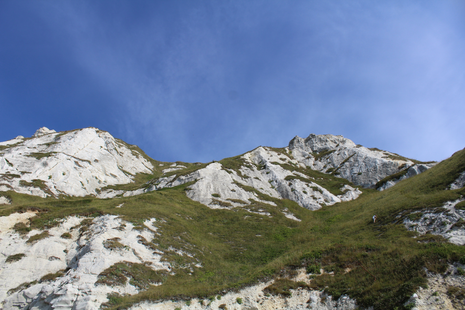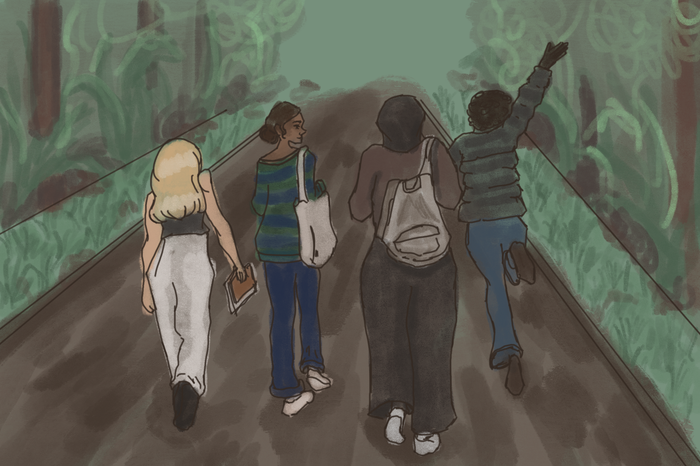Lamenting the lack of elevation in Cambridge: climbing the White Cliffs of Dover
Callum McGrath reflects on Cambridge’s signature flatness and the climbing culture spawned from it

The chalky ground beneath me threatens to crumble away. I am some 80 metres up the White Cliffs of Dover, using tufts of grass as ladder rungs to haul myself further into the sky. The top of the cliff lies just a few metres above, but getting there means a sideways traverse, away from the stable grass holds, and onto an exposed arête sliced between two overhangs. My stomach lurches as I train my eyes down the slope, trickles of dislodged pebbles bouncing off into the void beneath me. As my palms dampen with sweat in the searing July heat, the realisation hits me that a descent would be riskier than to continue up. I suddenly feel very small, very alone, and a long way from the flat refuge of Cambridge.
It may be famed for its minds, but Cambridge is no place for climbers. Characterised by a relentlessly flat landscape shaped by centuries of the River Cam’s drainage, this is the UK’s flattest city. Spots like Midsummer Common or Jesus Green offer open, uninterrupted skies, with the iconic towers of King’s Chapel visible on the horizon from miles around.
This flatness has seen biking become the city’s favoured mode of transport. While this is handy if you’re running late to a lecture, the landscape can feel stifling and monotonous for those seeking more varied terrain. Despite being 40 miles inland, much of Cambridge’s elevation sits at only 10 metres; some of the county’s areas are even below sea level. So, it was here, in these endless fens, that my inspiration came to seek an entirely different landscape – to climb the White Cliffs of Dover.
“The desire to climb is not new to the University, with the ‘night climbers’ perhaps being one of Cambridge’s most fascinating secret societies”
“Ottavio,” I said, pointing to the cliffs towering above us back in the summer. “Reckon someone could reach the top of that?”
“I doubt it,” my friend replied. “Way too steep. Maybe if, well actually I don’t think…”
And so, the seed was planted. The cliffs loomed large in my mind in the ensuing weeks of corporate monotony during this interval between academic years. When our days off aligned, we returned to Dover. Our location was Samphire Hoe, a nature reserve composed of nearly five million cubic metres of rubble deposits from the Channel Tunnel excavation. We chose this section of the cliff as it is less steep than the vertical, postcard-esque cliffs above the Port of Dover a kilometre down the coast. Instead of the panoramic skies offered at Cambridge, here we indulged in expansive horizons of the English Channel, with distant ferries like caterpillars on an infinitely blue leaf, and France visible just 22 miles away.
Like Cambridge, the Dover Cliffs are entrenched in history. They represented the bastion of British freedom from a seemingly imminent Nazi invasion during the early years of World War II. Soldiers were stationed in tunnels here, using pioneering technology developed by many of the brilliant minds of the time. King’s College alumni Alan Turing, for instance, cracked the German Enigma code, significantly helping Britain’s war victory. But the history of these cliffs dates back much further.
“The University has also produced pioneering adventurers over the years, most notable of which was early Everest explorer George Mallory, who studied at Magdalene between 1905 to 1909”
Around 30 years before Cambridge University was founded, Henry II built Dover Castle in the 1180s. Some 500 years prior, Saint Augustine brought Christianity to Britain when he landed a few miles up the coast – a legacy reflected in the iconic church architecture of Cambridge’s college chapels.
The desire to climb is not new to the University, with the ‘night climbers’ perhaps being one of Cambridge’s most fascinating secret societies. Shrouded in mystery, this group have scaled some of the town’s most iconic buildings in the cover of darkness since the early 20th century. One member abseiled into a Trinity Ball in 2000, and in 2009, the group made national headlines after leaving four Santa hats on the spires of King’s Chapel.
“By contrast, the Rambling Club are unbothered by this lack of elevation”
The University has also produced pioneering adventurers over the years, most notable of which was early Everest explorer George Mallory, who studied at Magdalene between 1905 to 1909. In his book Mountains of the Mind, Emmanuel Fellow Robert Macfarlane recounts his Cantabrigian longing for elevation: “Stuck on the tablelands of Cambridgeshire… I lusted for a break. The only relief was the dark church towers which punctuated the horizon, and the white spires of the colleges, pirouetting away into thin air.”
By contrast, the Rambling Club are unbothered by this lack of elevation. “The flatness can mess with your mind on long distances when you see the expanses of impossible vastness, but it’s kind of exciting when that happens,” their Treasurer tells me. “I love mountains, but the flat land here has charm and character too.” Cambridge’s Mountaineering Club (CUMC) keeps this spirit of adventure alive, offering regular trips to the Peak District.
For me, this longing led me to Dover. Upon reaching the beach that scorching July day, we gazed at the rock above, drawing a potential route in our minds. Far from being a place of barren sterility, the cliff face was alive. During my free-solo ascent (no safety ropes), I passed beetles, orchids and bees, all thriving in this isolated utopia, a place idyllic for them but perilous for us.
Reaching the top was a moment of bliss, earned through fear and fatigue as the panorama of the English Channel unfurled in front of me. But my thoughts drifted back to Cambridge. Returning here reminded me that adventure isn’t confined to the highest places or most dazzling viewpoints; it can be found anywhere with serenity, challenge and the space to dream. Cambridge may not soar, but it gives us the wings to do so.
 Features / Should I stay or should I go? Cambridge students and alumni reflect on how their memories stay with them15 December 2025
Features / Should I stay or should I go? Cambridge students and alumni reflect on how their memories stay with them15 December 2025 News / Cambridge study finds students learn better with notes than AI13 December 2025
News / Cambridge study finds students learn better with notes than AI13 December 2025 Comment / The magic of an eight-week term15 December 2025
Comment / The magic of an eight-week term15 December 2025 News / News In Brief: Michaelmas marriages, monogamous mammals, and messaging manipulation15 December 2025
News / News In Brief: Michaelmas marriages, monogamous mammals, and messaging manipulation15 December 2025 News / Uni Scout and Guide Club affirms trans inclusion 12 December 2025
News / Uni Scout and Guide Club affirms trans inclusion 12 December 2025










